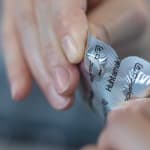
Chronic diseases are more widespread than ever before. In industrial nations and, increasingly, in developing countries as well, they are among the most common and economically relevant health problems.
The health sector’s global economic factor is accordingly high, and simultaneously acts as leverage for the pharmaceutical industry, which invests a comparably high share of its revenue in research and development (R&D).
In light of global demographic changes, the industry’s development opportunities are excellent. People are living longer and more health-conscious lives – which further increases the high-tech sector’s growth outlook. Growing drug development requirements result in a parallel increase in systems and machine technology demands in the field of packaging and bottling medicines. “Today, pharmaceutical companies need integrated solutions. Machines provide the foundation for these. An extensive service offer and digital solutions in particular are gaining in importance,” explains Norbert Gruber, Chairman of the Executive Board at Uhlmann, which provides systems for packaging pharmaceuticals in blister packs, bottles and boxes. The German family business, which has more than 2,300 employees around the world, has accordingly positioned itself as an innovative and digitalised company at interpack 2020, the world’s leading trade fair for the packaging and associated process industries.
From 7 to 13 May 2020, the trade fair presents further cutting-edge solutions that the industry has to offer. As a focal point for pharmaceutical packaging, Halls 15 to 17 offer visitors the opportunity to find out more about innovative packaging and process developments for this specific industry. The other halls also showcase corresponding solutions: The approximately 1,000 companies with exhibits on Industry 4.0, digitalisation, automation, personalisation, track and trace and many other interesting topics from the field of pharmaceuticals represent a significant share of the around 3,000 exhibitors at interpack.
Pharmaceutical market forecast
According to figures released by market research company IQVIA, global expenditures for pharmaceuticals are expected to increase to 1,43 trillion[1] US dollars by 2022. In comparison: In 2006, expenditures amounted to 658 billion US dollars. The highest amount is spent on cancer medication and biopharmaceuticals.
The reasons for this increase in market growth are quite apparent: Demographic change with a rise in older patients and increasing urbanisation with a growing middle class are the determining market factors for the pharmaceutical sector and the associated process and packaging industries.
The future of biopharmaceuticals
Whilst in pharmerging countries, more and more people are gaining access to traditional medicines such as painkillers and antibiotics, industrial nations are increasingly employing new, complex active ingredients and innovative treatments.
In the pharmaceutical sector, biotechnology is considered a key technology in the global fight against severe diseases such as cancer and autoimmune diseases. Their share in the medical market has almost doubled in the past ten years[2] and has thus become a decisive factor for the process and packaging industry.
Sophisticated processing
Highly effective medicine is accompanied by considerable demands on packaging and processing technologies, particularly with regard to bottling and packaging solutions. When manufacturing biotech medicines, avoiding contamination is essential. Special containment solutions aim to prevent said contamination.
Isolators are one such example. Liquid medicines can be processed under sterile conditions in vials. Pre-filled syringes also contribute to an increase in safety. They help prevent dosage errors and also eliminate contamination when changing needles. In the hectic daily life of practices and clinics, pre-filled syringes and pens also save precious time. Authenticity checks performed on complex purification processes using combined sensor technology and mathematical models ensure that quality controls can be performed much more quickly with increased process accuracy.
Pharmaceuticals and packaging: True team play
When manufacturers launch new pharmaceuticals, they depend on the market and technology competence of machine, systems and packaging manufacturers and processors. Time limits on patent protection require fast and flexible solutions that have to guarantee scale-ups from small laboratory amounts to high volumes in larger plants.
Optima is a single-source provider of packaging machines and bottling and production systems. To ensure that newly developed products can be launched as quickly as possible, Optima uses the CSPE method, which will be one of the company’s central topics at interpack 2020. This method reduces delivery times and significantly accelerates the commissioning of pharmaceutical systems. “In light of increased development periods and costs on the one hand and increasingly tough international competition on the other, the time between concluding the approval phase and launching the product has to be kept as short as possible,” explains Gerhard Breu, Chairman of Optima’s Pharma division.
At the same time, companies require reliable packaging machines and bottling systems that are easy to use and clean, and that can be retrofit without great effort. Pharmaceutical service provider Harro Höflinger provides support in the early stages. His clean rooms and laboratories can depict extensive processes in a controlled environment, whilst test setups allow clients to check critical steps in advance. “Our clients increasingly ask to test their own substances and critical conditioning products on machines designed by Harro Höflinger. Our clean rooms and laboratories are the perfect place to implement these tests. They allow us to recognise and minimise risks at an early stage – the basis for quick and safe scale-ups to commercial manufacture,” explains Stefan Mayer, Senior Director Process Services.


